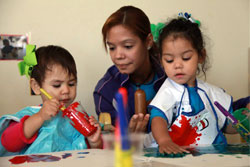
What are open-ended prompts?
Open-ended prompts are questions or statements that support children’s verbal and nonverbal communication. The purpose of open-ended prompts is to encourage extended responses, which promote children’s language development by meeting children where they are. To encourage optimal language growth for all children, educators tailor open-ended prompts to meet individual needs. For example, educators may need to provide more time and support for children to process information and then respond as they are able. The complexity of prompts should be based on children’s readiness levels and communication skills.
Why is it important to use open-ended prompts with children?
It’s important for educators to ask children open-ended questions and statements like, “Tell me more about your drawing” or “What are you doing this weekend?” because they invite children to use more than one word in their response. Open-ended prompts are an important strategy that educators can use with children to open the dialogue and extend conversation, providing opportunities for children to practice language. Effective questions such as, “What is your favorite…? or “Tell me about…?” not only encourage back-and-forth exchanges and develop communication skills, but they can also offer valuable information about children.
How can educators grow their Language Modeling interactions by using ended prompts?
- Consider the frequency, depth, and duration of the educator-child interactions.
- Frequency—the number of times the behaviors or interactions occur.
- Depth—the impact of the interaction on the child.
- Duration—the length of an interaction and whether it is short-lived or sustained.
- Meet students where they are and individualize prompts.
- Promote language by asking open-ended questions that are differentiated based on children’s language abilities and communication skills.
- Use verbal and nonverbal cues
- Communicate in the home language, if possible.
- Consider the wait time so that children can fully respond before moving on.
- Use strategies to encourage children to engage in conversations with one another as they answer the open-ended prompts.
When should educators ask open-ended prompts?
All day long! Ideally, educators and children should participate in back-and-forth conversations all day. Open-ended questions or statements can lead to longer conversations while children are arriving in the morning and getting settled. It also can lead to dialogues between students, which can be helpful during arrival when there are only a few students in the room and teachers juggle managerial tasks.
